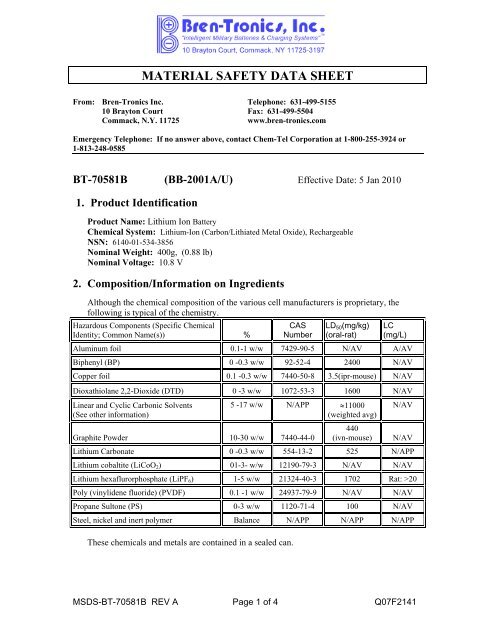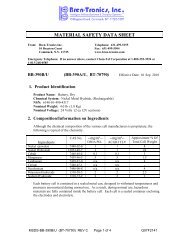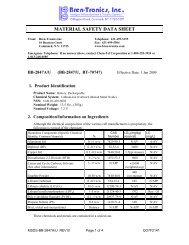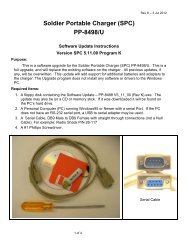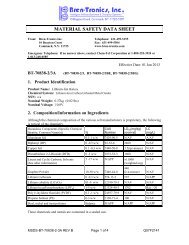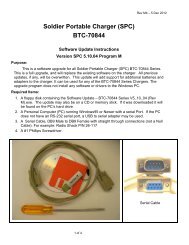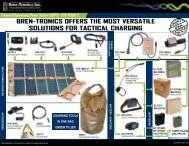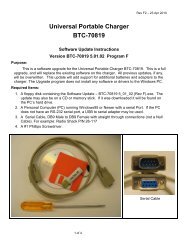MSDS - Bren-Tronics
MSDS - Bren-Tronics
MSDS - Bren-Tronics
Create successful ePaper yourself
Turn your PDF publications into a flip-book with our unique Google optimized e-Paper software.
MATERIAL SAFETY DATA SHEETFrom: <strong>Bren</strong>-<strong>Tronics</strong> Inc. Telephone: 631-499-515510 Brayton Court Fax: 631-499-5504Commack, N.Y. 11725www.bren-tronics.comEmergency Telephone: If no answer above, contact Chem-Tel Corporation at 1-800-255-3924 or1-813-248-0585BT-70581B (BB-2001A/U) Effective Date: 5 Jan 20101. Product IdentificationProduct Name: Lithium Ion BatteryChemical System: Lithium-Ion (Carbon/Lithiated Metal Oxide), RechargeableNSN: 6140-01-534-3856Nominal Weight: 400g, (0.88 lb)Nominal Voltage: 10.8 V2. Composition/Information on IngredientsAlthough the chemical composition of the various cell manufacturers is proprietary, thefollowing is typical of the chemistry.Hazardous Components (Specific ChemicalIdentity; Common Name(s)) %CASNumberLD 50 (mg/kg)(oral-rat)LC(mg/L)Aluminum foil 0.1-1 w/w 7429-90-5 N/AV A/AVBiphenyl (BP) 0 -0.3 w/w 92-52-4 2400 N/AVCopper foil 0.1 -0.3 w/w 7440-50-8 3.5(ipr-mouse) N/AVDioxathiolane 2,2-Dioxide (DTD) 0 -3 w/w 1072-53-3 1600 N/AVLinear and Cyclic Carbonic Solvents(See other information)5 -17 w/w N/APP ≈11000(weighted avg)Graphite Powder 10-30 w/w 7440-44-0440(ivn-mouse)N/AVN/AVLithium Carbonate 0 -0.3 w/w 554-13-2 525 N/APPLithium cobaltite (LiCoO 2 ) 01-3- w/w 12190-79-3 N/AV N/AVLithium hexaflurorphosphate (LiPF 6 ) 1-5 w/w 21324-40-3 1702 Rat: >20Poly (vinylidene fluoride) (PVDF) 0.1 -1 w/w 24937-79-9 N/AV N/AVPropane Sultone (PS) 0-3 w/w 1120-71-4 100 N/AVSteel, nickel and inert polymer Balance N/APP N/APP N/APPThese chemicals and metals are contained in a sealed can.<strong>MSDS</strong>-BT-70581B REV A Page 1 of 4 Q07F2141
3. Hazards IdentificationRoutes of Entry:Inhalation?Skin?Ingestion?Not anticipated. Respiratory (and eye) irritation may occur if fumes arereleased due to heat or an abundance of leaking batteries.YesYesPotential Health Effects:These chemicals are contained in a sealed can. Risk of exposure occurs only if thebattery is mechanically or electrically abused. The most likely risk is acute exposurewhen a cell vents. Propylene Carbonate is mildly irritating upon eye and skin contact.Contact of electrolyte and extruded lithium with skin and eyes should be avoided.Inhalation or ingestion of lithium trifluoromethane sulfonate may be harmful.Signs/Symptoms of Exposure:Skin and eye irritation may occur following exposure to a leaking battery.Medical Conditions Generally Aggravated by Exposure:An acute exposure will not generally aggravate any medical condition.4. First Aid MeasuresEmergency & First Aid Procedures:If battery is leaking and material contacts eyes, flush with copious amounts of clear,tepid water for thirty (30) minutes, exposed skin for at least fifteen (15) minutes.Contact Physician at once. Leaking contents may be irritating to respiratory passages.Remove to fresh air. Contact physician if irritation persists. If ingested, rinse mouthand surrounding area with clear, tepid water for at least fifteen (15) minutes. Consultphysician immediately for treatment and to rule out involvement of the esophagus andother tissues.5. Fire Fighting MeasuresExtinguishing Media:Water spray, Carbon Dioxide, dry chemical powder or appropriate foam. Use agentappropriate for surrounding materialsSpecial Fire Fighting Procedures:In burning, wear self-contained breathing apparatus and protective clothing to prevent contactwith skin and eyes.Unusual Fire and Explosion Hazards:Organic components will burn if cell incinerated. Combustion of cell contents will causeevolution of extremely corrosive Hydrogen Fluoride gas.6. Accidental Release MeasuresVentilation:None under normal use conditions.Protective Gloves:None under normal use conditions. Use butyl gloves when handling leaking batteries.Eye Protection:None under normal use conditions. Wear safety glasses when handling leakingbatteries.<strong>MSDS</strong>-BT-70581B REV A Page 2 of 4 Q07F2141
7. Handling and StoragePrecautions to be Taken in Handling and Storage:Store batteries in a cool, dry area. While the storage temperature range extends from -4°F to122°F, (-20°C to +50°C), the battery longevity is maximized when stored at or below 70ºF(23ºC). Short term excursions higher than above temperature range (to 158ºF (70ºC) max) areallowable but may result in reduced battery service life. Do not place near heating equipment,ovens, etc.Other Precautions:Do not disassemble battery or battery pack. Do not puncture, crush or dispose of in fire.8. Exposure Controls/Personal ProtectionSteps to be Taken in Case Material is Released or Spilled:Notify safety personnel of large spills. Evacuate the area and allow vapors to dissipate.Increase ventilation. Avoid eye or skin contact. DO NOT inhale vapors. Clean uppersonnel should wear appropriate protective gear. Remove spilled liquid with absorbentand contain for disposal.Transport containers outdoors. Hold burned cells and fire cleanup solids for disposal aspotential hazardous waste. Unburned cells are not hazardous waste. A fire with over 100 kg ofburned cells will likely require reporting to environmental offices. Always consult and obey allinternational, federal and local environmental laws.9. Physical and Chemical PropertiesAppearance:Rectangular box shape10. Stability and ReactivityStability:StableConditions to Avoid:Do not heat, crush, disassemble, short-circuit or recharge.Hazardous Decomposition or By-products:Thermal degradation may produce hazardous fumes of manganese and lithium;hydrofluoric acid; oxides of carbon and sulfur and other toxic by-products.Hazardous Polymerization:Will not occur.Incompatible Materials:Contents incompatible with strong oxidizing agents.11. Toxicological InformationCarcinogenicity: NTP? IARC Monograph? OSHA Regulated?No No No12. Ecological InformationN/A13. Disposal Considerations• Batteries must be completely discharged prior to disposal and/or the terminals must be taped orcapped to prevent short circuit.• Disposal of large quantities of batteries containing lithium cells may be subject to Federal, Stateor local regulations.<strong>MSDS</strong>-BT-70581B REV A Page 3 of 4 Q07F2141


